Eggplants, with their glossy purple exterior, are a versatile and delicious addition to many dishes. However, determining the freshness of an eggplant from the outside can be challenging. In this comprehensive guide, we will delve into the visual cues, explore the repercussions of a brown interior, discuss insights from the Reddit community, and provide practical tips to distinguish between good and bad eggplants.
When purchasing eggplant, it’s crucial to assess the texture and appearance of the flesh. A fresh eggplant should have firmness but give slightly when pressed, bouncing back to its original state. Any softness to the touch is a clear indication that the eggplant is beginning to spoil. Additionally, if the flesh feels slimy, it’s best to discard the eggplant as it has surpassed its freshness.
Concerning the color of the inside, brown spots or dark shading in the eggplant are not necessarily signs of spoilage. If there are no accompanying indicators such as softness, slime, or off-putting odors, the eggplant is safe to consume. The brown spots are likely a result of enzymatic browning, and the flesh around the seeds may have tan to brown-colored spots, which are edible.
To identify a bad eggplant, look for wrinkled and dull-colored skin, as well as a squishy texture and a rotten odor. Fresh eggplants have a limited shelf life, lasting 2-3 days at room temperature, 5 days in the refrigerator, and 8-12 months in the freezer. If you’ve sliced the eggplant and notice it turning brown, it is still safe to eat.
When considering the softness inside an eggplant, it should be soft but not excessively spongy. If the texture is too spongy, the eggplant may be bruised or too old, indicating a breakdown that renders it inedible. A fresh eggplant should have firm skin and slightly softer white inside, but not more than 50% softer as a general rule.
Identifying Freshness: The Visual Inspection
Examining the Skin Texture and Color
Is the surface of the eggplant smooth and free from blemishes? A fresh eggplant typically has a shiny, unblemished skin. To ensure optimal freshness, run your fingers over the surface. If you feel any soft spots or irregularities, it may be an indication of spoilage.
A glossy appearance is a key indicator of a healthy eggplant. The skin should be taut and free from wrinkles or dullness. Additionally, vibrant, uniform coloration is a positive sign. Any deviations from the characteristic purple hue may signal potential issues inside the eggplant.
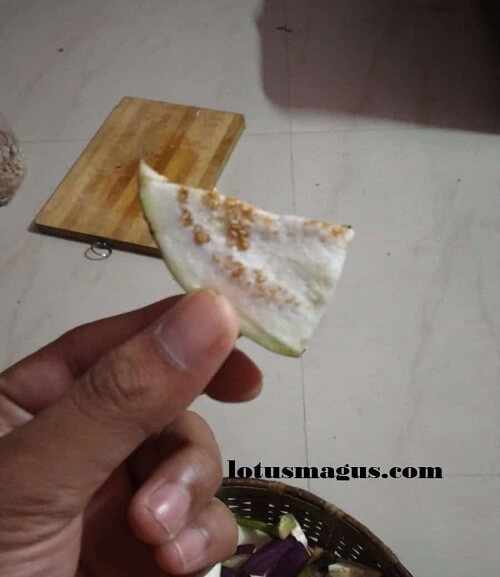
Differentiating Between Good and Bad Eggplant through External Cues
While discoloration on the skin is a crucial aspect, it’s not the sole factor in determining freshness. Check for a firm texture by gently pressing the eggplant with your fingertips. Fresh eggplants should yield slightly but still maintain their overall firmness. If the eggplant feels mushy or excessively soft, it may be past its prime.
Inspect the stem and cap as well. The green cap, also known as the calyx, should be vibrant and firmly attached. A withered or discolored cap may suggest deterioration within the eggplant.
Detailed Analysis of Pictures Showcasing Bad Eggplants
For a visual aid in recognizing bad eggplants, refer to the following table:
| Visual Cue | Indication of Spoilage |
|---|---|
| Wrinkled Skin | Potential loss of freshness |
| Discoloration | Sign of internal decay |
| Soft Spots | Areas prone to mold or rot |
| Wilted or Brown Cap | External evidence of aging |
| Dull or Matte Finish | Lack of vibrancy, hinting at internal issues |
Visual cues, when combined, offer a comprehensive assessment of an eggplant’s freshness. By referencing images, you can better understand the subtleties that distinguish good from bad.
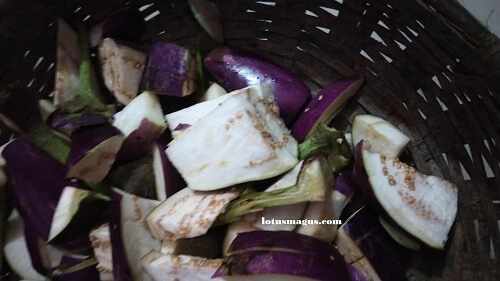
What Happens if Eggplant is Brown Inside?
Understanding the Reasons Behind Eggplant Discoloration
Brown discoloration inside an eggplant can be disconcerting, but it’s crucial to comprehend the underlying causes. Oxidation and enzymatic browning, triggered by exposure to air, can lead to the development of brown spots or an entirely brown interior. Additionally, bacterial or fungal growth may contribute to discoloration, signaling potential spoilage.
The breakdown of cell walls and the release of enzymes within the eggplant can result in accelerated browning. This process is often accelerated by improper storage, physical damage, or extended periods of exposure to air.
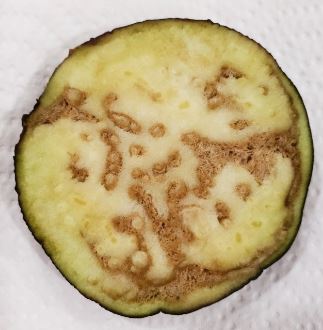
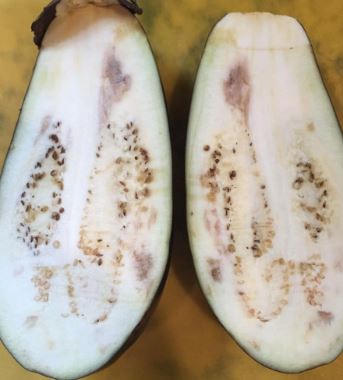
Effects of Consuming Eggplants with Brown Interiors
Consuming eggplants with brown interiors is generally not recommended. The discoloration is often an indicator of compromised texture, flavor, and nutritional quality. While some instances of minimal browning may be harmless, extensive discoloration suggests a decline in overall freshness and potential microbial activity.
It’s essential to note that eating spoiled eggplants can lead to digestive discomfort, as harmful bacteria or molds may be present. To avoid adverse effects, it’s advisable to err on the side of caution and discard eggplants with significant brown discoloration.
Health Risks Associated with Bad Eggplants
The health risks associated with consuming bad eggplants are primarily tied to microbial contamination. Bacteria and molds can thrive in the moist, nutrient-rich environment of a spoiled eggplant, posing a risk of foodborne illness. Symptoms may include nausea, vomiting, abdominal pain, and diarrhea.
In cases of severe spoilage, mycotoxins produced by molds may be present, further elevating health risks. To safeguard your well-being, it’s essential to adopt preventive measures and prioritize the consumption of fresh, high-quality eggplants.
Addressing Concerns about Partial Spoilage
If you encounter an eggplant with only minor brown spots, you might wonder if it’s still safe to consume. In such cases, a pragmatic approach involves evaluating the extent of discoloration. Small, isolated brown spots may be trimmed, allowing you to salvage the remaining edible portions of the eggplant.
However, exercise caution when considering this approach. If the brown discoloration is pervasive or extends beyond surface-level blemishes, it’s advisable to discard the entire eggplant to avoid potential health risks.
I found that the signs of a bad eggplant inside are black mouse poop-like sclerotia in dead stems, soft and rotted fruit, and cottony white mycelia inside and outside infected stems during high humidity. Additionally, frost damage or chilling injury may cause water-soaked and black leaves, bronzed fruit surfaces, and brown seeds inside the fruit.
https://apps.extension.umn.edu/garden/diagnose/plant/vegetable/eggplant/fruitspots.html
https://apps.extension.umn.edu/garden/diagnose/plant/vegetable/eggplant/fruitdiscoloredinside.html
The Community’s Insights

Highlights from Discussions on “How to Tell if Eggplant is Bad Inside”
I am sharing the different users thought about it.
When determining the freshness of an eggplant, it’s essential to examine it for any brown spongy spots or white growth, as these are indicators that the vegetable may be spoiled. Opt for an eggplant without these undesirable features to ensure its quality.
Upon cutting open the eggplant, inspect the inside carefully. A green interior with brown dots is generally acceptable. Take note of the texture – it should be firm to the touch. If you encounter any softness accompanied by large brown spots, it indicates rot, and the eggplant may not be suitable for consumption.
In the case of tiny brown dots inside the eggplant, especially if it has been stored in a plastic bag for some days, these are likely just seeds. Feel free to cut them out and proceed with cooking if the rest of the flesh appears fine.
If there are holes resembling sponge or tight spider webs, it might raise concerns about mold. However, the outside being glossy and firm suggests that it might be cosmetic, as eggplants tend to oxidize quickly.
Remember that the overall taste and texture of eggplant can be influenced by various factors. If the eggplant looks okay but you’re unsure about its ripeness, check the firmness of the flesh. Firm and unbruised or non-mushy flesh is an indication of freshness.
Additionally, eggplants with fewer seeds tend to have a higher water content, making them a preferable choice. Anthocyanin, a pigment in eggplants, can turn blue under alkaline conditions, but this doesn’t necessarily mean the food has gone bad.
In the event of discovering dark spots inside a cut eggplant, cutting out the affected areas and cooking the rest is often deemed safe, especially if the internal sections appear unaffected.
The Cutting Edge: Eggplant Brown Inside When Cut
Step-by-Step Guide on Cutting an Eggplant to Reveal its Interior
- Inspecting the Exterior (Subheading)
- Before cutting, reevaluate the eggplant’s external features.
- Confirm that the skin is firm, the color is vibrant, and there are no evident signs of spoilage.
- Choosing the Right Knife (Subheading)
- Opt for a sharp, sturdy knife to ensure clean cuts.
- A dull knife may crush the eggplant, making it challenging to discern subtle discolorations.
- Cutting Techniques (Subheading)
- Make a longitudinal cut through the eggplant to expose its interior.
- Examine the cross-section for any deviations from the expected color and texture.
- Observing Internal Characteristics (Subheading)
- Look for consistent coloration and firmness throughout the interior.
- Any brown discoloration or mushy areas may indicate spoilage.
- Documenting Findings (Subheading)
- Capture images of the cut eggplant for future reference.
- These visuals can be valuable when seeking advice from online communities or tracking changes in freshness over time.
Recognizing Signs of Spoilage While Preparing Eggplant Dishes
When incorporating eggplants into recipes, it’s essential to remain vigilant for signs of spoilage during the preparation process. The following steps can help ensure the quality of your dishes:
- Pre-Wash Inspection (Subheading)
- Thoroughly wash the eggplant before cutting.
- Use a brush or cloth to remove any surface contaminants that may contribute to spoilage.
- Trimming Techniques (Subheading)
- Employ precise trimming to remove any visibly spoiled sections.
- Trim at least half an inch beyond the visibly affected areas to ensure removal of potential contaminants.
- Monitoring Changes During Cooking (Subheading)
- Keep a watchful eye on the eggplant’s appearance as it cooks.
- Unwanted discoloration or off-putting odors may become more apparent during the cooking process.
- Testing Texture and Flavor (Subheading)
- Periodically sample the cooking eggplant for changes in texture and flavor.
- Any unexpected alterations may signal spoilage, prompting further investigation.
- Cross-Referencing with Visual Guides (Subheading)
- Compare the cooked eggplant’s appearance with visual guides.
- This cross-reference can provide additional assurance of the dish’s quality.
Good vs. Bad Eggplant: A Visual Guide
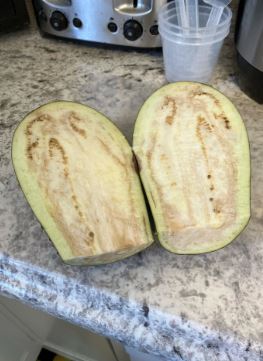
Side-by-Side Visual Comparison of Healthy and Spoiled Eggplants
The nuances that distinguish good from bad eggplants may not always be apparent without a visual guide. Let’s explore a detailed comparison:
| Visual Cue | Healthy Eggplant | Spoiled Eggplant |
|---|---|---|
| Skin Texture | Smooth, taut, and glossy | Wrinkled, dull, or matte |
| Coloration | Vibrant and uniform purple | Discolored patches, brown or yellow hues |
| Firmness | Firm, yielding slightly to pressure | Soft or mushy in certain areas |
| Cap and Stem Appearance | Green and firmly attached | Wilted, discolored, or detached |
| Interior Cross-Section | Consistent, white to pale cream color | Brown discoloration, mushy texture, or irregular patterns |
Creating a comprehensive chart for easy reference allows for quick visual assessments when deciding whether an eggplant is suitable for consumption.
Tips on Distinguishing Key Features Between Good and Bad Eggplants
- Utilize Natural Light (Subheading)
- Examine eggplants in natural light to enhance visibility.
- Sunlight reveals subtle discolorations that may be less noticeable under artificial lighting.
- Rotate the Eggplant (Subheading)
- Rotate the eggplant in your hands to inspect all sides.
- This 360-degree assessment ensures a thorough examination of the entire surface.
- Smell Test (Subheading)
- Bring the eggplant close to your nose and take a gentle sniff.
- Any unpleasant or off-putting odors may indicate spoilage.
- Comparative Analysis (Subheading)
- Keep a reference image of a healthy eggplant for direct comparison.
- This visual aid serves as a benchmark for assessing deviations in color, texture, and overall appearance.
Frequently Asked Questions (FAQs)
- How Do I Store Eggplants to Prolong Freshness?
- Proper storage involves refrigeration and placing eggplants in perforated plastic bags.
- Refrigerate eggplants at temperatures between 45°F and 50°F (7°C to 10°C) for optimal freshness.
- Can I Eat Eggplants with Minor Discoloration?
- Minor discoloration may be trimmed, but extensive brown areas should prompt discarding.
- Trim at least half an inch beyond visible brown spots to ensure removal of potential contaminants.
- What Causes Eggplants to Turn Brown Inside?
- Oxidation, enzymatic browning, and microbial growth contribute to brown discoloration.
- Exposure to air, physical damage, and improper storage are common catalysts for internal browning.
- Are There Any Signs of Bad Eggplant That Aren’t Visible from the Outside?
- Unpleasant odors, excessive moisture, and changes in texture may not be immediately visible but are indicative of spoilage.
- Employ multiple senses, including smell and touch, to assess eggplant freshness comprehensively.
- Is It Safe to Eat Slightly Wrinkled Eggplants?
- Mild wrinkling may be acceptable, but excessively wrinkled skin may indicate loss of freshness.
- Consider the overall condition of the eggplant, including firmness and color, before deciding on consumption.
- How Long Can I Keep Eggplants in the Refrigerator?
- Fresh eggplants can be stored in the refrigerator for up to one week.
- To prevent moisture buildup, place eggplants in perforated plastic bags before refrigeration.
- Can Cooking Disguise the Taste of Bad Eggplant?
- Cooking may mask some undesirable flavors, but it won’t rectify spoilage-related issues.
- It’s safer to use fresh, high-quality eggplants to ensure the best culinary outcomes.
- Are There Any Health Benefits to Eating Eggplants with Brown Spots?
- Brown spots may indicate a decline in nutritional quality.
- Consuming eggplants with extensive brown discoloration may expose you to potential health risks.
- What Role Does Temperature Play in Eggplant Spoilage?
- Cold temperatures slow down enzymatic browning and microbial activity.
- Proper refrigeration is crucial to preserving eggplant freshness and preventing spoilage.
- How Do I Revive a Slightly Bad Eggplant for Consumption?
- Reviving slightly bad eggplants is challenging.
- It’s advisable to prioritize fresh ingredients for optimal taste and nutritional value.
The Taste Test Experiment
Conducting a Taste Test to Confirm Spoilage
When in doubt about the freshness of an eggplant, a taste test can provide additional clarity.
- Preparing the Eggplant (Subheading)
- Cook the eggplant using your preferred method.
- Ensure that the cooking process is thorough, as some spoilage indicators may become more pronounced during cooking.
- Sampling and Observing (Subheading)
- Take a small, cautious bite of the cooked eggplant.
- Pay attention to any off-putting flavors, unusual textures, or lingering aftertastes.
- Documenting Findings (Subheading)
- Record your observations, including flavor profile and texture.
- Compare these findings with your expectations based on the initial assessment of the eggplant’s external and internal characteristics.
- Considering Overall Culinary Experience (Subheading)
- Evaluate the dish as a whole, taking into account the contribution of the eggplant to the overall flavor.
- If any undesirable qualities are detected, it may be an indication of spoilage.
- Final Decision (Subheading)
- Based on the taste test results, make an informed decision on whether to continue or discard the dish.
- Trust your senses and prioritize food safety when in doubt.
Conclusion
In conclusion, mastering the art of identifying bad eggplants is crucial for ensuring the quality and safety of your culinary creations. By paying attention to visual cues, understanding the reasons behind discoloration, and incorporating insights from the Reddit community, you empower yourself to make informed decisions in the kitchen.
In this guide, we’ve explored the impact of brown interiors on eggplants and the potential health risks associated with consuming spoiled produce. The step-by-step guide on cutting and inspecting eggplants, along with the visual comparison chart, provides a practical toolkit for anyone seeking to enhance their eggplant selection skills.
The FAQs offer solutions to common queries, addressing storage, the significance of brown spots, and potential health risks. By embracing the taste test experiment, you take a proactive approach to confirming the freshness of your eggplants, ensuring a delightful culinary experience.
Remember, the journey to becoming a discerning eggplant connoisseur involves a combination of visual inspection, community insights, and hands-on experimentation. By honing your skills in recognizing the subtle signs of spoilage, you contribute to a safer and more enjoyable kitchen environment.
As you embark on your eggplant exploration, share your newfound knowledge with friends and family, creating a community of informed cooks dedicated to the pursuit of culinary excellence. Happy cooking, and may your eggplant endeavors be filled with freshness and flavor!
